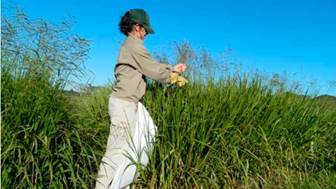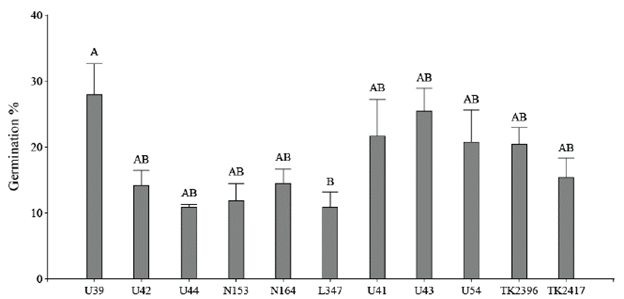Introduction
Beef-cattle production systems in South America are based mostly on natural rangelands with only a small proportion of cultivated forage species (Berretta 2001; Maraschin 2001; Royo Pallarás et al. 2005). For example, in Argentina, only 10-20% of the total area used for livestock production is under sown species. Furthermore, in Northeastern Argentina, which is a subtropical region, only 4.5% of the total area is sown to predominantly warm-season grasses (Arelovich et al. 2011; Feldkamp 2011). The exception is Brazil, where 61% of the total area devoted to livestock production is sown with cultivated forage species, predominantly Brachiaria spp. (Jank et al. 2014). In South America, most forages sown in pasturelands have been introduced from Africa (Moser et al. 2004). However, there are several forage species, indigenous to South America, that have been widely sown in improved beef cattle production systems in the subtropics. For example, the grass Paspalum notatum(Gates et al. 2004) and the legume Stylosanthes guianensis(Skerman et al. 1991) were selected directly from wild populations, based on their agronomic qualities.
Since wild species have evolved in this environment, it seems logical to evaluate wild grasses and legumes to assess their potential as cultivated forages. The native genus Paspalum appears to possess great forage potential in South America. This genus contains about 330 species that grow in the New World (Zuloaga and Morrone 2005). The Plicatula group is an informal taxonomic group of Paspalum(Chase 1929) that contains about 30 species, most of which are recognized as good quality forages . This group contains those species related to P. plicatulum Michx., characterized by spikelets with transversely wrinkled lemma and shining dark brown anthecium. Species within the Plicatula group vary in many characters, notably morphological characteristics, with the geographic center of variation of the group occupying Central and Western Brazil, Eastern Bolivia and Paraguay (Quarin et al. 1997). Most species of the Plicatula group are important native forages and some have become cultivated pasture plants .
Species of the Plicatula group reproduce primarily by apomixis, which is an asexual mode of reproduction through seed, present in more than 500 species distributed in 40 families (Savidan 2007). The genus Paspalum contains the highest number of apomictic species in the Poaceae family (Ortiz et al. 2013).
Genetic improvement of apomictic species has been achieved mostly through ecotype selection (Blount and Acuña 2009). In apomictic species ecotypes are individual genotypes that have been able to colonize a particular area (Brugnoli et al. 2014) and new cultivars resulting from the selection of superior ecotypes have the distinction of being highly stable in their agronomic characteristics .
Within the Plicatula group, P. atratum Swallen and P. lenticulare Kunth are characterized by rapid growth. Paspalum atratum, a warm-season grass grown on seasonally waterlogged, infertile, acid soils in the tropics and sub-tropics (Evers and Burson 2004), is a perennial bunchgrass that is larger and more robust than P. plicatulum. It is an apomictic tetraploid (2n=4x=40) native species from Brazil with high potential forage yield, good palatability and good seed yield (Quarin et al. 1997).
On the other hand, P. lenticulare is a multiploid species with diploid (2n=20), tetraploid (2n=40) and hexaploid (2n=60) cytotypes. Diploids reproduce sexually while polyploids are apomictic (Galdeano et al. 2016). The most common cytotype is tetraploid (Norrmann et al. 1994; Espinoza et al. 2001). The species is distributed throughout seasonally inundated savannas in Eastern Bolivia, Paraguay and the Center-West region of Brazil.
There is growing interest in developing native species as cultivated forages. Regional evaluation of native ecotypes of promising apomictic species may offer a valuable approach for identifying potential new cultivars. Protection and preservation of native species is also of importance and this is simultaneously addressed through the submission of native ecotype seed or vegetative collections to various national and international germplasm banks. At present, germplasm of many Paspalum species from different locations in South America and the rest of the world is conserved at the Instituto de Botánica del Nordeste (IBONE) in Northeastern Argentina.
The objectives of this research were to evaluate seasonal growth, frost tolerance, cattle preference, nutritional characteristics, seed yield and field germination of wild accessions of P. atratum and P. lenticulare collected from different locations in South America and grown in Northeastern Argentina. Additionally, the chromosome numbers in 2 accessions were determined to ensure all conserved germplasm is characterized by its ploidy level.
Materials and Methods
Plant material
Five accessions of P. atratum and 6 of P. lenticulare collected from different sites in South America were used in this study. The origins and chromosome numbers of these accessions are described in Table 1. Seeds have been maintained in seed storage at moisture content below 10% and approximately 5 °C.
Table 1 Origin and chromosome number of Paspalum atratum and P. lenticulare accessions used in the study.
| Species and | Origin | Chromosome number and | |
| accession | reference | ||
| P. atratum | |||
| U39 | Brazil, Miranda, Mato Grosso do Sul | 40 | Freitas et al. 1997 |
| U42 | Brazil, Aquidauana, Mato Grosso do Sul | 40 | Pagliarini et al. 2002 |
| U44 | Brazil, Cáceres, Mato Grosso do Sul | 40 | Freitas et al. 1997 |
| N153 | Paraguay, Guayaibí, Dpto. Caa Guazú | 40 | Espinoza et al. 2001 |
| N164 | Paraguay, Bella Vista, Arroyo Alegre and route 3, Dpto. Amambay | 40 | Espinoza et al. 2001 |
| P. lenticulare | |||
| L347 | Paraguay, near the Aguaray-mí River, Dpto. San Pedro | 40 | This work |
| U41 | Brazil, Miranda, Mato Grosso do Sul | 40 | Freitas et al. 1997 |
| U43 | Paraguay, Bella Vista, Dpto. Amambay | 40 | Pagliarini et al. 1999 |
| U54 | Cultivated in FCA-UNNE. Selection from TK2417 | 60 | This work |
| TK2396 | Bolivia, Estancia El Recreo, Concepción, Prov. Ñuflo de Chávez, Dept. Santa Cruz | 40 | Espinoza et al. 2001 |
| TK2417 | Bolivia, Estancia Viera, Concepción, Prov. Ñuflo de Chávez, Dept. Santa Cruz | 40 | Espinoza et al. 2001 |
Seed of each accession was sown in plots in the greenhouse in September 2011, and germinated seedlings were transplanted to planting trays 2 weeks later. These plants were transferred to a field site, previously native rangeland, near the city of Corrientes, Argentina (27°38' S, 58°44' W) on 7 November 2011 in plots of 2.7 m2 (1.7 x 1.6 m) using a randomized complete block design with 3 replications. Each plot contained 30 plants uniformly distributed over the plot. The soil was classified as Aquic Argiudoll, a fine loam with slope between 1 and 1.5% (Escobar et al. 1996). At the beginning of the experiment the soil pH was 5.5, the P concentration 4.8 ppm (Bray II method), the K concentration 0.14 meq/100 g, and OM 1. 18%. Fertilizer was not applied in this study following a low-input pasture system which is typical management in livestock production of tropical and subtropical regions.
Chromosome counting
Chromosome numbers of 9 of the 11 accessions used in this study were reported in past publications (Table 1), and chromosome numbers of the remaining 2 accessions were determined using root tips of young plants grown in pots in the greenhouse. Root tips were collected in the morning, washed and pretreated in a saturated solution of a-bromonaphthalene for 2 h, and hydrolyzed in 1 N HCl for 10 min at 60 °C. They were then macerated in a drop of acetocarmine stain, heated, pressed under a cover-slip, and observed using a light microscope (Leica DM 2500®) at 200 and 1000 X magnification.
Seasonal growth
Seasonal growth was determined by harvesting plots using a sickle bar mower leaving a 10-cm stubble height. An 80 x 100 cm strip was cut from the middle of each plot, the forage was collected, weighed and a subsample of approximately 300 g was taken immediately. The subsample from each entry was weighed and oven-dried at 60 °C for 48 h to determine percent DM and forage yield. Plots were harvested on 15 March and 3 May 2012 during the 2011/2012 growing season; 28 November 2012, 23 January and 28 March 2013 during the 2012/2013 growing season; and 4 December 2013, 8 January and 8 April 2014 during the 2013/2014 growing season.
Crude protein concentration, in vitro dry matter digestibility and cattle preference
At the harvest in January 2014, clipped subsamples were taken for determination of in vitro dry matter digestibility (IVDMD) and crude protein (CP) concentration in the harvested forage. Samples were analyzed for IVDMD using the technique described by Tilley and Terry (1963). Crude protein concentration was determined following the method of Association of Official Analytical Chemists by determining nitrogen concentration (Kjeldahl method) and multiplying the value obtained by 6.25.
The plots were grazed by cattle (cows) in September 2013 and February 2015 using mob grazing for 4 h duration at a stocking rate of 60 cows/ha. Cattle preference was evaluated using a visual scale from 1 to 5 where 1 represented lightly grazed and 5 heavily grazed. The observations were performed on plots by 2 observers immediately after the cows were removed from the experimental area.
Cool-season regrowth and frost tolerance
Cool-season regrowth and frost tolerance were evaluated after the first frosts occurring on 7 and 8 June 2012 with a minimal temperature of -1.8 °C, and temperatures below 0 °C for 4 h on each day. The regrowth was estimated visually 30 days after the frost event using a 1-5 scale, where 1 = plants showing limited regrowth and 5 = plants showing high amounts of regrowth as described by Acuña et al. . Frost tolerance was estimated visually 3 days after the frost using a 1 -5 scale, where 1 = the least frost-tolerant and 5 = the most frost-tolerant plant as described by Zilli et al. (2015) and Novo et al. (2017).
Flowering time
Flowering date was determined by making weekly observations until the complete emergence of inflorescences in all plots. This evaluation was performed during the second and third growing seasons (2012/2013 and 2013/2014).
Seed yield and germination
Mature inflorescences were harvested by hand on 20 May 2014 (Figure 1). Inflorescences were air-dried, threshed and the fully formed, mature caryopses were separated from empty ones using a seed blower (Seedburo Equipment Company 1022W) and weighed to assess yields.
A field germination test was conducted in October 2014 in a plot previously cultivated with Avena strigosa. The sowing was done with an experimental no-till seeder a week after applying glyphosate at 3 L/ha. The seed was sown superficially using 2.3 m rows separated by 1 m. Rows were arranged following a randomized complete block design with 3 replications. Emerged plants were counted 15 days after sowing, and percentage germination was calculated.
Statistical analysis
The generated data were analyzed using Info-Gen software (Balzarini and Di Rienzo 2004) as a randomized complete block design. Means, coefficients of variation, analysis of variance (ANOVA) and mean separations by the Tukey test were calculated. Unless otherwise stated in the text, all differences refer to significance at P<0.05.
Results
Seasonal growth
There were no significant differences among accessions for annual forage accumulation (Table 2) but differences occurred between years with yields for the first, second and third years of 5.70, 11.72 and 12.29 t DM/ha, respectively. Growth rate varied with season of the year (Figure 2) with lowest growth during establishment, which was related to an unusually dry period (Figure 3), and between the end of the fall and the beginning of spring, while highest growth rates occurred during the warm season (December-March) through to mid-fall.
Table 2 Forage yields (t DM/ha) of accessions of Paspalum atratum and P. lenticulare during 3 consecutive growing seasons.
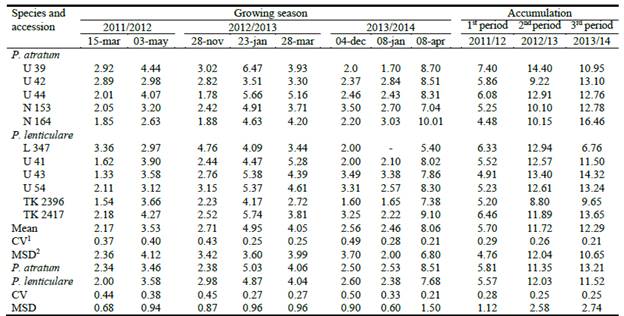
1Coefficient of variation; 2Minimum significant difference.
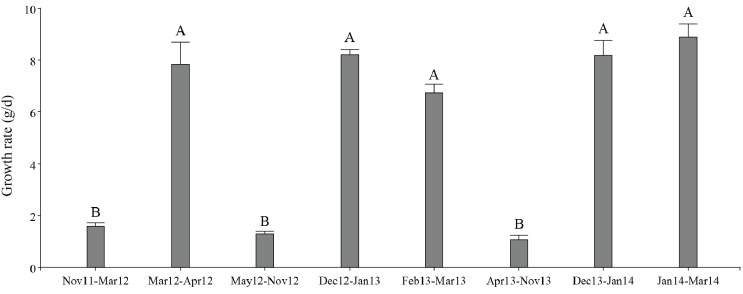
Figure 2 Growth rates of accessions of Paspalum atratum and P. lenticulare between November 2011 and March 2014. Different letters indicate significant statistical differences (P<0.05).
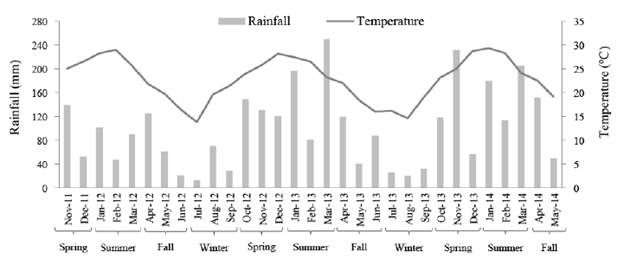
Figure 3 Monthly rainfall and mean temperature for each of the 3 growing seasons at Riachuelo, Corrientes, Argentina (27º38’ S, 58º44’ W).
Crude protein concentration, in vitro dry matter digestibility and cattle preference
No significant differences among the accessions were observed for CP concentration and IVDMD of 4-week regrowth (Table 3); mean CP concentration was 87 g/kg DM and mean IVDMD, 525 g/kg DM. Accession L347 of P. lenticulare was not evaluated for nutritive value because it did not survive during winter 2013.
Table 3 Crude protein (CP) concentration and in vitro dry matter digestibility (IVDMD) of Paspalum atratum and P. lenticulare accessions.
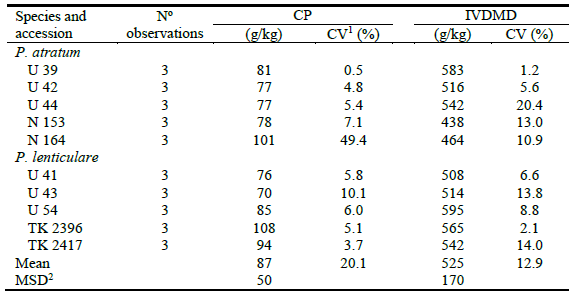
1Coefficient of variation; 2Minimum significant difference.
Differences between accessions in terms of cattle preference were observed in both years of evaluation (September 2013 and February 2015) (Figure 4). Cattle preferentially grazed accession P. atratum U44 in both years (Figure 5). However, correlations between IVDMD or CP concentration and cattle preference were not significant.
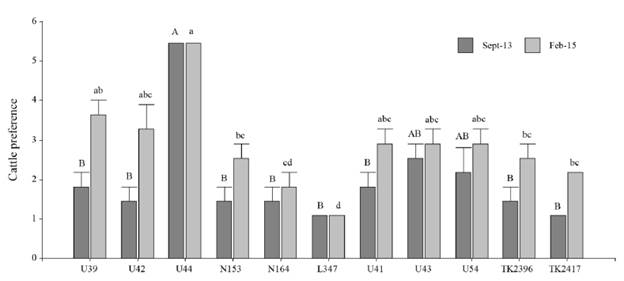
Figure 4 Cattle preference for Paspalum atratum and P. lenticulare accessions based on a visual scale (1-5) in September 2013 and February 2015. Different letters on columns indicate significant statistical differences (P<0.05). Uppercase letters belong to Sep-13 and lowercase letters to Feb-15.
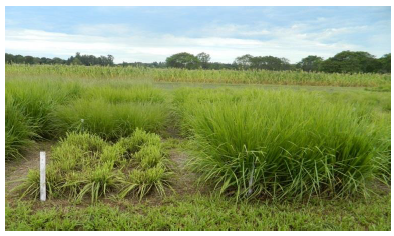
Figure 5 Preferential grazing of accession Paspalum atratum U44 (left plot) over the other ecotypes during summer 2015.
Cool-season regrowth and frost tolerance
After 2 consecutive frost events (7 and 8 June 2012) with temperatures below 0 °C for 4 h on both days, the leaves of all accessions were uniformly frosted and plants did not regrow for a period of 1 month after the initial frost. Therefore, we were unable to evaluate and rate frost tolerance and subsequent winter-time regrowth. While most accessions survived the winter, and regrowth occurred in October when mean air temperature was 24 °C, one accession, P. lenticulare L347, did not survive the second winter period.
Flowering time
Accession L347 (P. lenticulare) began flowering in early spring through September 2012, while all other accessions remained vegetative until late March 2013 (data not shown).
Seed yield and germination
Significant differences were observed among all evaluated accessions for seed yield (Figure 6). Accession P. lenticulare L347 had the lowest yield with 90 kg/ha and accession P. lenticulare U43 exhibited the highest production with 540 kg/ha. Mean seed yield of the group was 280 kg/ha. There were no differences in seed yields between P. atratum and P. lenticulare (310 vs. 260 kg/ha) (P>0.05).
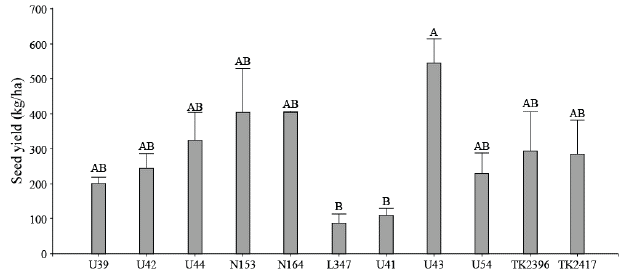
Figure 6 Seed yield of Paspalum atratum and P. lenticulare accessions evaluated during fall 2014. Different letters on columns indicate significant statistical differences (P<0.05).
Germination under field conditions was significantly different among accessions (Figure 7). Accession P. atratum U39 displayed the highest germination (28%) while P. lenticulare L347 and P. atratum U44 exhibited the lowest (11%). Overall mean germination percentage was 16% for P. atratum and 19% for P. lenticulare.
Discussion
We hypothesized that the introduction of native forage species into rangeland-based beef cattle production systems in the subtropics could increase the productive potential of these rangelands. To test this hypothesis the first step was to evaluate the growth and quality of some promising native grass species. In this research we evaluated a group of wild apomictic ecotypes of Paspalum atratum and P. lenticulare for a series of agronomic and forage quality characteristics.
Forage yield is the most important trait to consider before introducing a new cultivar into a pasture system. The mean yields we obtained during the second and third years from P. atratum and P. lenticulare (up to 11.7 and 12.8 t DM/ha) were quite substantial and quality wasacceptable at 8.7% CP and 52.5% IVDMD. This was despite the fact that soils in this area of subtropical Argentina are generally inherently low in fertility and are acidic as they are in many pasturelands of South Brazil, Paraguay, Uruguay, Bolivia and Peru, and no fertilizer was applied. Typically pastures utilized by grazing cattle in the tropics and subtropics are not fertilized, so accessions evaluated in this study were not fertilized to obtain a more realistic evaluation of their potential under low-input pasture systems. As was expected, accessions in this study behaved as perennials in this region of Argentina, except for P. lenticulare accession L347, which behaved as a biennial.
The yield and quality data are similar or superior to those recorded for cultivated grass species frequently used in South America. For example, Setaria sphacelata cv. Narok is one of the most cultivated forages in Northeastern Argentina because of its ability to regrow rapidly after the winter and produce acceptable yields of good quality forage. Llamas et al. (2016) reported that this cultivar produced 5.1 t DM/ha/yr in Chaco, Argentina on an unfertilized Oxic Argiudoll soil with a harvest frequency of 40 days. Another example is Brachiaria brizantha cv. Marandu, the most cultivated warm-season grass in subtropical South America because of its high production in the acid soils of this region. This cultivar produced 3.75 t DM/ha/yr on infertile soils at Campo Grande, MS, Brazil with the addition of 50 kg N + 40 kg P + 40 kg K/ha (Euclides et al. 2008). Forage production of P. atratum and P. lenticulare is similar to or better than that of other species of the same genus such as P. notatum cv. Argentine, which is one of the principal cultivated forage species in the Coastal Plain region of Southeastern United States of America. Vendramini et al. (2013) reported annual forage yields of Argentine bahiagrass between 4.3 and 6.4 t DM/ha at the University of Florida Range Cattle Research and Education Center, Ona, FL, following the addition of 56 kg N + 14 kg P + 24 kg K/ha 2 weeks after planting and 60 kg N/ha annually. Similarly, P. atratum cv. Suerte produced 8.9-9.8 t DM/ha and 9.911.0 t DM/ha/yr following nitrogen fertilization of 180 kg N/ha and 220 kg N/ha, respectively, in north and central Florida (Kalmbacher et al. 1997).
The concentration of growth of P. atratum and P. lenticulare during late spring, summer and early fall was not surprising, as these are tropical-subtropical grasses. With the exception of P. lenticulare L347 all accessions of both species had exclusive vegetative growth during the spring-summer period with a concentrated flowering and seed production during the fall. Both species were considered to be frost-sensitive, but able to survive the mild winters of the subtropics. This is a common response of warm-season perennial grasses when grown in the subtropics (Moser et al. 2004). These characteristics allow for overseeding with annual winter forages, like Avena strigosa or Lolium multiflorum, to maintain adequate levels of forage production throughout the year. However, attempts are being made to breed strains of Paspalum species with increased forage production during the cool-season (Blount and Acuña 2009).
The mean CP concentration and IVDMD values for the accessions were similar to those of other warm-season grasses cultivated in the subtropics like B. brizantha cv. Marandu or S. sphacelata. Euclides at al. (2009) reported leaf CP of 9.2% and IVDMD of 53.2% in Marandu when fertilized with 50 kg N + 120 kg P + 40 kg K/ha prior to grazing in Campo Grande, MS. The mean CP percentage and IVDMD values of S. sphacelata in South Sulawesi, Indonesia without fertilization were 7.2% and 68.2%, respectively (Nasrullah et al. 2004).
While cattle preferentially grazed P. atratum accession U44, differences in acceptability were not related to the CP and IVDMD levels or the growing seasons, and may be due to differences in tactile and visual leaf texture, as the more palatable accession had softer leaves. However, further evaluations are needed to determine why cattle preferred U44, and if intakes were correspondingly higher on this grass.
Time to flowering was considered an important factor in this study. Ten of the 11 accessions we studied had a long vegetative phase and a concentrated reproductive phase at the end of the growing season. Only one accession, P. lenticulare L347, flowered early. This characteristic has also been observed in other species and cultivars of Paspalum, like P. atratum cv. Cambá FCA and P. guenoarum cv. Chané FCA (Evers and Burson 2004). However, this behavior is not displayed by other grasses like P. notatum(Blount and Acuña 2009) and S. sphacelata that commence flowering early in November-December. An extended vegetative phase is considered advantageous as a longer duration of vegetative growth could result in a higher leaf percentage and better nutritive value at any given time. A concentrated reproductive phase may result in more uniform ripening of seed and better seed harvest.
The mean seed yield obtained in this study (280 kg/ha) can be considered most acceptable for a native warm-season perennial grass which is undomesticated. The most common cultivated species in the tropics and subtropics actually produce similar seed yields. Seed yields reported in the literature are: 57 kg/ha/yr for S. sphacelata cv. Narok receiving 50 kg N/ha at monthly intervals at Lawes, Australia over 2 years (Hacker 1991); 75 kg/ha for P. dilatatum(Evers and Burson 2004); and 110-220 kg/ha for P. atratum cv. Suerte (Kalmbacher et al. 1997). The mean field germinations for the Paspalum accessions, evaluated 5 months after seed harvest, of 16 and 19%, would allow good grass stands to be achieved with low amounts of seed sown (Newman and Moser 1988; Masters et al. 2004). However, further research is needed to determine if seed dormancy is limiting germination soon after harvest, a common characteristic in species of Paniceae (Loch et al. 2004).
Conclusions
This study has shown that P. atratum and P. lenticulare have an extended warm-season growth and, despite being sensitive to low temperature, survived frosting. Their high forage and seed yields, as well as their capacity to survive the winter season in the subtropics, suggest that these undomesticated species can produce well in the northeast of Argentina and with their good seed yields may be potential candidates for sowing in the humid subtropics of South America as well as similar locations around the world. Most accessions are late-flowering, with a concentrated reproductive phase during the fall. This results in an extended period when forage quality should be acceptable, with the added benefit that seed harvesting should be more efficient with concentrated seed-set and ripening in the fall.
The extended growing period and persistence during the cold season should be compatible with over-sowing of the stands with winter-growing species to extend the period of productive forage availability. Considering that the accessions did not differ in forage yield, CP percentage and IVDMD, other factors like the high palatability of P. atratum U44 may determine the accession to sow in a given situation. Additional research is warranted to evaluate these accessions further in terms of persistence under grazing and animal performance in a beef cattle production system.













